Evolution of the Electromagnetic Manipulation: From Tunable to Programmable and Intelligent Metasurfaces
Abstract
:1. Introduction
2. Tunable Metasurfaces
3. Active and Programmable Metasurfaces
4. Intelligent Metasurfaces
5. Conclusions
Author Contributions
Funding
Conflicts of Interest
References
- Veselago, V.G. Electrodynamics of substances with simultaneously negative and. Usp. Fiz. Nauk 1967, 92, 517. [Google Scholar] [CrossRef]
- Smith, D.R.; Kroll, N. Negative refractive index in left-handed materials. Phys. Rev. Lett. 2000, 85, 2933. [Google Scholar] [CrossRef] [Green Version]
- Houck, A.A.; Brock, J.B.; Chuang, I.L. Experimental observations of a left-handed material that obeys Snell’s law. Phys. Rev. Lett. 2003, 90, 137401. [Google Scholar] [CrossRef]
- Garcia, N.; Nieto-Vesperinas, M. Left-handed materials do not make a perfect lens. Phys. Rev. Lett. 2002, 88, 207403. [Google Scholar] [CrossRef]
- Pendry, J.B.; Holden, A.J.; Stewart, W.J.; Youngs, I. Extremely low frequency plasmons in metallic mesostructures. Phys. Rev. Lett. 1996, 76, 4773–4776. [Google Scholar] [CrossRef] [Green Version]
- Pendry, J.B.; Holden, A.J.; Robbins, D.J.; Stewart, W.J. Magnetism from conductors and enhanced nonlinear phenomena. IEEE Trans. Microw. Theory Tech. 1999, 47, 2075–2084. [Google Scholar] [CrossRef] [Green Version]
- Shelby, R.A.; Smith, D.R.; Schultz, S. Experimental verification of a negative index of refraction. Science 2001, 292, 77–79. [Google Scholar] [CrossRef] [PubMed] [Green Version]
- Valentine, J.; Zhang, S.; Zentgraf, T.; Ulin-Avila, E.; Genov, D.A.; Bartal, G.; Zhang, X. Three-dimensional optical metamaterial with a negative refractive index. Nature 2008, 455, 376. [Google Scholar] [CrossRef] [PubMed]
- Veselago, V.G.; Narimanov, E.E. The left hand of brightness: Past, present and future of negative index materials. Nat. Mater. 2006, 5, 759–762. [Google Scholar] [CrossRef] [PubMed]
- Xiao, S.; Drachev, V.P.; Kildishev, A.V.; Ni, X.; Chettiar, U.K.; Yuan, H.-K.; Shalaev, V.M. Loss-free and active optical negative-index metamaterials. Nature 2010, 466, 735. [Google Scholar] [CrossRef] [PubMed]
- Zhang, S.; Fan, W.J.; Panoiu, N.C.; Malloy, K.J.; Osgood, R.M.; Brueck, S.R.J. Experimental demonstration of near-infrared negative-index metamaterials. Phys. Rev. Lett. 2005, 95, 137404. [Google Scholar] [CrossRef] [Green Version]
- Ma, Q.; Shi, C.B.; Chen, T.Y.; Qi, M.Q.; Li, Y.B.; Cui, T.J. Broadband metamaterial lens antennas with special properties by controlling both refractive-index distribution and feed directivity. J. Opt. 2018, 20, 045101. (In English) [Google Scholar] [CrossRef]
- Kaina, N.; Lemoult, F.; Fink, M.; Lerosey, G. Negative refractive index and acoustic superlens from multiple scattering in single negative metamaterials. Nature 2015, 525, 77–81. [Google Scholar] [CrossRef] [PubMed]
- Kundtz, N.; Smith, D.R. Extreme-angle broadband metamaterial lens. Nat. Mater. 2010, 9, 129–132. [Google Scholar] [CrossRef]
- Pendry, J.B. Negative refraction makes a perfect lens. Phys. Rev. Lett. 2000, 85, 3966–3969. [Google Scholar] [CrossRef]
- Schurig, D.; Mock, J.; Justice, B.; Cummer, S.A.; Pendry, J.B.; Starr, A.; Smith, D.R. Metamaterial Electromagnetic Cloak at Microwave Frequencies. Science 2006, 314, 977–980. [Google Scholar] [CrossRef] [Green Version]
- Liang, Q.; Li, Z.; Jiang, Z.; Duan, Y.; Chen, T.; Li, D. A 3D-printed adaptive cloaking-illusion-integrated metasurface. J. Mater. Chem. C 2020, 8, 16018–16023. [Google Scholar] [CrossRef]
- Ergin, T.; Stenger, N.; Brenner, P.; Pendry, J.B.; Wegener, M. Three-dimensional invisibility cloak at optical wavelengths. Science 2010, 328, 337–339. (In English) [Google Scholar] [CrossRef] [PubMed] [Green Version]
- Hui, F.M.; Cui, T.J. Three-dimensional broadband ground-plane cloak made of metamaterials. Nat. Commun. 2010, 1, 21. [Google Scholar]
- Ma, Q.; Mei, Z.L.; Zhu, S.K.; Jin, T.Y.; Cui, T.J. Experiments on active cloaking and illusion for laplace equation. Phys. Rev. Lett. 2013, 111, 173901. [Google Scholar] [CrossRef] [PubMed]
- Yang, F.; Mei, Z.L.; Jin, T.Y.; Cui, T.J. dc Electric Invisibility Cloak. Phys. Rev. Lett. 2012, 109, 053902. [Google Scholar] [CrossRef] [Green Version]
- Xiang, N.; Cheng, Q.; Chen, H.B.; Zhao, J.; Jiang, W.X.; Ma, H.F.; Cui, T.J. Bifunctional metasurface for electromagnetic cloaking and illusion. Appl. Phys. Express 2015, 8, 092601. [Google Scholar] [CrossRef]
- Ma, Q.; Yang, F.; Jin, T.Y.; Mei, Z.L.; Cui, T.J. Open active cloaking and illusion devices for the Laplace equation. J. Opt. 2016, 18, 044004. (In English) [Google Scholar] [CrossRef]
- Han, T.; Bai, X.; Gao, D.; Thong, J.T.L.; Li, B.; Qiu, C.-W. Experimental Demonstration of a Bilayer Thermal Cloak. Phys. Rev. Lett. 2014, 112, 054302. [Google Scholar] [CrossRef] [Green Version]
- Jha, P.K.; Ni, X.; Wu, C.; Wang, Y.; Zhang, X. Metasurface-Enabled Remote Quantum Interference. Phys. Rev. Lett. 2015, 115, 025501. [Google Scholar] [CrossRef] [PubMed] [Green Version]
- Cui, T.-J.; Liu, S.; Li, L.-L. Information entropy of coding metasurface. Light-Sci. Appl. 2016, 5, e16172. [Google Scholar] [CrossRef] [PubMed]
- Aristov, A.I.; Zywietz, U.; Evlyukhin, A.B.; Reinhardt, C.; Chichkov, B.N.; Kabashin, A.V. Laser-ablative engineering of phase singularities in plasmonic metamaterial arrays for biosensing applications. Appl. Phys. Lett. 2014, 104, 071101. [Google Scholar] [CrossRef]
- Xu, W.; Huang, Y.; Zhou, R.; Wang, Q.; Yin, J.; Kono, J.; Ying, Y. Metamaterial-Free Flexible Graphene-Enabled Terahertz Sensors for Pesticide Detection at Bio-Interface. ACS Appl. Mater. Interfaces 2020, 12, 44281–44287. [Google Scholar] [CrossRef] [PubMed]
- Shin, D.; Urzhumov, Y.; Jung, Y.; Kang, G.; Baek, S.; Choi, M.; Smith, D.R. Broadband electromagnetic cloaking with smart metamaterials. Nat. Commun. 2012, 3, 1213. [Google Scholar] [CrossRef] [Green Version]
- Fang, N.; Lee, H.; Sun, C.; Zhang, X. Sub-diffraction-limited optical imaging with a silver superlens. Science 2005, 308, 534–537. (In English) [Google Scholar] [CrossRef] [Green Version]
- Leonhardt, U. Perfect imaging without negative refraction. New J. Phys. 2009, 11, 093040. (In English) [Google Scholar] [CrossRef]
- Huang, L.; Chen, X.; Mühlenbernd, H.; Zhang, H.; Chen, S.; Bai, B.; Qiu, C.-W. Three-dimensional optical holography using a plasmonic metasurface. Nat. Commun. 2013, 4, 2808. [Google Scholar] [CrossRef] [Green Version]
- Ding, X.; Wang, Z.; Hu, G.; Liu, J.; Zhang, K.; Li, H.; Ratni, B.; Burokur, S.N.; Wu, Q.; Tan, J.; et al. Metasurface holographic image projection based on mathematical properties of Fourier transform. PhotoniX 2020, 1, 16. [Google Scholar] [CrossRef]
- Wang, D.; Liu, C.; Shen, C.; Xing, Y.; Wang, Q.-H. Holographic capture and projection system of real object based on tunable zoom lens. PhotoniX 2020, 1, 6. [Google Scholar] [CrossRef] [Green Version]
- Zhao, R.; Huang, L.; Wang, Y. Recent advances in multi-dimensional metasurfaces holographic technologies. PhotoniX 2020, 1, 20. [Google Scholar] [CrossRef]
- Zou, X.; Zhen, G.; Yuan, Q.; Zang, W.; Zhu, S. Imaging based on metalenses. PhotoniX 2020, 1, 2. [Google Scholar] [CrossRef] [Green Version]
- Cheng, Q.; Cui, T.J.; Jiang, W.X.; Cai, B.G. An omnidirectional electromagnetic absorber made of metamaterials. New J. Phys. 2010, 12, 063006. (In English) [Google Scholar] [CrossRef]
- Ma, H.F.; Cui, T.J. Three-dimensional broadband and broad-angle transformation-optics lens. Nat. Commun. 2010, 1, 124. [Google Scholar] [CrossRef] [PubMed] [Green Version]
- Mei, Q.Q.; Wen, X.T.; Cui, T.J. A Broadband Bessel Beam Launcher Using Metamaterial Lens. Sci. Rep. 2015, 5, 11732. [Google Scholar]
- Chen, X.; Ma, H.F.; Zou, X.Y.; Jiang, W.X.; Cui, T.J. Three-dimensional broadband and high-directivity lens antenna made of metamaterials. J. Appl. Phys. 2011, 110, 044904. (In English) [Google Scholar] [CrossRef]
- Jiang, W.X.; Qiu, C.W.; Han, T.C.; Cheng, Q.; Ma, H.F.; Zhang, S.; Cui, T.J. Broadband all-dielectric magnifying lens for far-field high-resolution imaging. Adv. Mater. 2013, 25, 6963–6968. [Google Scholar] [CrossRef]
- Huang, S.-T.; Hsu, S.-F.; Tang, K.-Y.; Yen, T.-J.; Yao, D.-J. Application of a Terahertz System Combined with an X-Shaped Metamaterial Microfluidic Cartridge. Micromachines 2020, 11, 74. [Google Scholar] [CrossRef] [Green Version]
- Lee, W.; Jung, Y.; Jung, H.; Seo, C.; Choo, H.; Lee, H. Wireless-Powered Chemical Sensor by 2.4 GHz Wi-Fi Energy-Harvesting Metamaterial. Micromachines 2019, 10, 12. [Google Scholar] [CrossRef] [Green Version]
- Sievenpiper, D.; Zhang, L.J.; Broas, R.F.J.; Alexopolous, N.G.; Yablonovitch, E. High-impedance electromagnetic surfaces with a forbidden frequency band. IEEE Trans. Microw. Theory Tech. 1999, 47, 2059–2074. [Google Scholar] [CrossRef] [Green Version]
- Yu, N.F.; Genevet, P.; Kats, M.A.; Aieta, F.; Tetienne, J.-P.; Capasso, F.; Gaburro, Z. Light Propagation with Phase Discontinuities: Generalized Laws of Reflection and Refraction. Science 2011, 334, 333–337. (In English) [Google Scholar] [CrossRef] [Green Version]
- Schlickriede, C.; Kruk, S.S.; Wang, L.; Sain, B.; Kivshar, Y.; Zentgraf, T. Nonlinear Imaging with All-Dielectric Metasurfaces. Nano Lett. 2020, 20, 4370–4376. [Google Scholar] [CrossRef]
- Shen, B.L.; Liu, L.; Li, Y.; Ren, S.; Yan, J.; Hu, R.; Qu, J. Nonlinear Spectral-Imaging Study of Second- and Third-Harmonic Enhancements by Surface-Lattice Resonances. Adv. Opt. Mater. 2020, 8, 1901981. [Google Scholar] [CrossRef]
- Wan, W.; Gao, J.; Yang, X. Metasurface holograms for holographic imaging. Adv. Opt. Mater. 2017, 5, 1700541. [Google Scholar] [CrossRef]
- Xin, M.; Xie, R.; Zhai, G.; Gao, J.; Zhang, D.; Wang, X.; Ding, J. Full control of dual-band vortex beams using a high-efficiency single-layer bi-spectral 2-bit coding metasurface. Opt. Express 2020, 28, 17374–17383. [Google Scholar] [CrossRef] [PubMed]
- Zheng, Q.; Li, Y.; Han, Y.; Feng, M.; Pang, Y.; Wang, J.; Zhang, J. Efficient orbital angular momentum vortex beam generation by generalized coding metasurface. Appl. Phys. A-Mater. Sci. Process. 2019, 125, 136. (In English) [Google Scholar] [CrossRef]
- Chen, Y.; Shen, W.G.; Li, Z.M.; Hu, C.Q.; Jin, X.M. Underwater transmission of high-dimensional twisted photons over 55 meters. PhotoniX 2020, 1, 5. [Google Scholar] [CrossRef] [Green Version]
- Fu, S.; Zhai, Y.; Zhang, J.; Liu, X.; Gao, C. Universal orbital angular momentum spectrum analyzer for beams. PhotoniX 2020, 1, 19. [Google Scholar] [CrossRef]
- Qiao, Z.; Wan, Z.; Xie, G.; Wang, J.; Qian, L.; Fan, D. Multi-vortex laser enabling spatial and temporal encoding. PhotoniX 2020, 1, 13. [Google Scholar] [CrossRef]
- Ni, X.; Wong, Z.J.; Mrejen, M.; Wang, Y.; Zhang, X. An ultrathin invisibility skin cloak for visible light. Science 2015, 349, 1310–1314. [Google Scholar] [CrossRef]
- Toan, D.P.; Le, K.Q.; Lee, J.-H.; Khang, N.T. A Designed Broadband Absorber Based on ENZ Mode Incorporating Plasmonic Metasurfaces. Micromachines 2019, 10, 673. [Google Scholar]
- Chen, L.; Ruan, Y.; Luo, S.S.; Ye, F.J.; Cui, H.Y. Optically Transparent Metasurface Absorber Based on Reconfigurable and Flexible Indium Tin Oxide Film. Micromachines 2020, 11, 1032. [Google Scholar] [CrossRef]
- Baier, M.; Grote, N.; Moehrle, M.; Sigmund, A. Integrated transmitter devices on InP exploiting electro-absorption modulation. PhotoniX 2020, 1, 4. [Google Scholar] [CrossRef]
- Guan, C.; Wang, Z.; Ding, X.; Zhang, K.; Ratni, B.; Burokur, S.N.; Wu, Q. Coding Huygens’ metasurface for enhanced quality holographic imaging. Opt. Express 2019, 27, 7108–7119. [Google Scholar] [CrossRef] [PubMed]
- Pfeiffer, C.; Grbic, A. Metamaterial Huygens’ Surfaces: Tailoring Wave Fronts with Reflectionless Sheets. Phys. Rev. Lett. 2013, 110, 197401. [Google Scholar] [CrossRef] [PubMed]
- Luo, Z.; Chen, M.Z.; Wang, Z.X.; Zhou, L.; Li, Y.B.; Cheng, Q.; Cui, T.J. Digital Nonlinear Metasurface with Customizable Nonreciprocity. Adv. Funct. Mater. 2019, 29, 1906635. (In English) [Google Scholar] [CrossRef]
- Ma, Q.; Chen, L.; Jing, H.B.; Hong, Q.R.; Cui, H.Y.; Liu, Y.; Cui, T.J. Controllable and Programmable Nonreciprocity Based on Detachable Digital Coding Metasurface. Adv. Opt. Mater. 2019, 7, 1901285. (In English) [Google Scholar] [CrossRef]
- Wang, X.; Zhang, G.; Li, H.; Zhou, J. Magnetically tunable Fano resonance with enhanced nonreciprocity in a ferrite-dielectric metamolecule. Appl. Phys. Lett. 2018, 112, 174103. [Google Scholar] [CrossRef]
- Bang, S.; Kim, J.; Yoon, G.; Tanaka, T.; Rho, J. Recent Advances in Tunable and Reconfigurable Metamaterials. Micromachines 2018, 9, 560. [Google Scholar] [CrossRef] [Green Version]
- Gil, I.; Bonache, J.; Garcia-Garcia, J.; Martin, F. Tunable metamaterial transmission lines based on varactor-loaded split-ring resonators. IEEE Trans. Microw. Theory Tech. 2006, 54, 2665–2674. [Google Scholar] [CrossRef]
- Zhang, F.; Zhao, Q.; Kang, L.; Gaillot, D.P.; Zhao, X.; Zhou, J. Magnetic control of negative permeability metamaterials based on liquid crystals. Appl. Phys. 2008, 92, 225–227. [Google Scholar]
- Zhao, Q.; Kang, L.; Du, B.; Li, B.; Zhou, J.; Tang, H.; Zhang, B. Electrically tunable negative permeability metamaterials based on nematic liquid crystals. Appl. Phys. Lett. 2007, 90, 011112. [Google Scholar] [CrossRef]
- Sun, S.; Jiang, W.; Gong, S.; Tao, H. Reconfigurable Linear-to-Linear Polarization Conversion Metasurface Based on PIN Diodes. IEEE Antennas Wirel. Propag. Lett. 2018, 17, 1722–1726. [Google Scholar] [CrossRef]
- Farzami, F.; Khaledian, S.; Smida, B.; Erricolo, D. Reconfigurable Linear/Circular Polarization Rectangular Waveguide Filtenna. IEEE Trans. Antennas Propag. 2017, 66, 9–15. [Google Scholar] [CrossRef]
- Clemente, A.; Dussopt, L.; Sauleau, R.; Potier, P.; Pouliguen, P. 1-Bit Reconfigurable Unit Cell Based on PIN Diodes for Transmit-Array Applications in X-Band. IEEE Trans. Antennas Propag. 2012, 60, 2260–2269. [Google Scholar] [CrossRef]
- Xu, W.; Sonkusale, S. Microwave diode switchable metamaterial reflector/absorber. Appl. Phys. Lett. 2013, 103, OP98–OP120. [Google Scholar] [CrossRef]
- Gupta, B.; Pandey, S.; Nahata, A.; Zhang, T.; Nahata, A. Bistable Physical Geometries for Terahertz Plasmonic Structures Using Shape Memory Alloys. Adv. Opt. Mater. 2017, 5, 1601008. [Google Scholar] [CrossRef]
- Chen, Z.; Rahmani, M.; Gong, Y.; Chong, C.T.; Hong, M. Realization of Variable Three-Dimensional Terahertz Metamaterial Tubes for Passive Resonance Tunability. Adv. Mater. 2012, 24, OP143–OP147. [Google Scholar]
- Ee, H.S.; Agarwal, R. Tunable Metasurface and Flat Optical Zoom Lens on a Stretchable Substrate. Nano Lett. 2016, 16, 2818–2823. [Google Scholar] [CrossRef]
- Huang, Y.W.; Lee, H.W.; Sokhoyan, R.; Pala, R.A.; Thyagarajan, K.; Han, S. Gate-Tunable Conducting Oxide Metasurfaces. Nano Lett. 2016, 16, 5319. [Google Scholar] [CrossRef] [Green Version]
- Ou, J.Y.; Plum, E.; Zhang, J.; Zheludev, N.I. An electromechanically reconfigurable plasmonic metamaterial operating in the near-infrared. Nat. Nanotechnol. 2013, 8, 252–255. [Google Scholar] [CrossRef] [PubMed]
- Xu, J.; Wang, J.; Yang, R.; Tian, J.; Chen, X.; Zhang, W. Frequency-tunable metamaterial absorber with three bands. Opt. Int. J. Light Electron Opt. 2018, 172, 1057–1063. [Google Scholar] [CrossRef]
- Zhang, X.G.; Tang, W.X.; Jiang, W.X.; Bai, G.D.; Tang, J.; Bai, L.; Cui, T.J. Light-Controllable Digital Coding Metasurfaces. Adv. Sci. 2018, 5, 1801028. [Google Scholar] [CrossRef]
- Xu, W.; Xie, L.; Ying, Y. Mechanisms and applications of terahertz metamaterial sensing: A review. Nanoscale 2017, 9, 13864–13878. [Google Scholar] [CrossRef] [PubMed]
- Grady, N.K.; Heyes, J.E.; Chowdhury, D.R.; Zeng, Y.; Reiten, M.T.; Azad, A.K.; Chen, H.-T. Terahertz Metamaterials for Linear Polarization Conversion and Anomalous Refraction. Science 2013, 340, 1304–1307. [Google Scholar] [CrossRef] [PubMed] [Green Version]
- Ni, X.; Kildishev, A.V.; Shalaev, V.M. Metasurface holograms for visible light. Nat. Commun. 2013, 4, 2807. [Google Scholar] [CrossRef]
- Yao, Y.; Shankar, R.; Kats, M.A.; Song, Y.; Kong, J.; Loncar, M.; Capasso, F. Electrically Tunable Metasurface Perfect Absorbers for Ultrathin Mid-Infrared Optical Modulators. Nano Lett. 2014, 14, 6526–6532. [Google Scholar] [CrossRef] [PubMed]
- della Giovampaola, C.; Engheta, N. Digital metamaterials. Nat. Mater. 2014, 13, 1115. [Google Scholar] [CrossRef] [PubMed] [Green Version]
- Cui, T.J.; Qi, M.Q.; Wan, X.; Zhao, J.; Cheng, Q. Coding metamaterials, digital metamaterials and programmable metamaterials. Light-Sci. Appl. 2014, 3, e218. (In English) [Google Scholar] [CrossRef]
- Cui, T.J.; Li, L.; Liu, S.; Ma, Q.; Zhang, L.; Wan, X.; Cheng, Q. Information Metamaterial Systems. iScience 2020, 23, 101403. [Google Scholar] [CrossRef] [PubMed]
- Xiao, Q.; Ma, Q.; Yan, T.; Wu, L.W.; Liu, C.; Wang, Z.X.; Cui, T.J. Orbital-Angular-Momentum-Encrypted Holography Based on Coding Information Metasurface. Adv. Opt. Mater. 2021, 9, 2002155. [Google Scholar] [CrossRef]
- Yan, T.; Ma, Q.; Sun, S.; Xiao, Q.; Shahid, I.; Gao, X.; Cui, T.J. Polarization Multiplexing Hologram Realized by Anisotropic Digital Metasurface. Adv. Theory Simul. 2021, 4, 2100046. [Google Scholar] [CrossRef]
- Zhang, L.; Wu, R.Y.; Bai, G.D.; Wu, H.T.; Ma, Q.; Chen, X.Q.; Cui, T.J. Transmission-Reflection-Integrated Multifunctional Coding Metasurface for Full-Space Controls of Electromagnetic Waves. Adv. Funct. Mater. 2018, 28, 1802205. (In English) [Google Scholar] [CrossRef]
- Bai, G.D.; Ma, Q.; Cao, W.K.; Li, R.Q.; Jing, H.B.; Mu, J. Manipulation of Electromagnetic and Acoustic Wave Behaviors via Shared Digital Coding Metallic Metasurfaces. Adv. Intell. Syst. 2019, 1, 1900038. [Google Scholar] [CrossRef]
- Jing, H.B.; Ma, Q.; Bai, G.D.; Bao, L.; Luo, J.; Cui, T.J. Optically transparent coding metasurfaces based on indium tin oxide films. J. Appl. Phys. 2018, 124, 023102. [Google Scholar] [CrossRef]
- Luo, J.; Ma, Q.; Jing, H.; Bai, G.; Wu, R.; Bao, L.; Cui, T.J. 2-bit amplitude-modulated coding metasurfaces based on indium tin oxide films. J. Appl. Phys. 2019, 126, 113102. [Google Scholar] [CrossRef]
- Ma, Q.; Shi, C.B.; Bai, G.D.; Chen, T.Y.; Noor, A.; Cui, T.J. Beam-Editing Coding Metasurfaces Based on Polarization Bit and Orbital-Angular-Momentum-Mode Bit. Adv. Opt. Mater. 2017, 5, 1700548. (In English) [Google Scholar] [CrossRef]
- Hong, Q.R.; Ma, Q.; Gao, X.X.; Liu, C.; Xiao, Q.; Iqbal, S.; Cui, T.J. Programmable Amplitude-Coding Metasurface with Multifrequency Modulations. Adv. Intell. Syst. 2021, 2000260. [Google Scholar] [CrossRef]
- Bai, G.D.; Ma, Q.; Iqbal, S.; Bao, L.; Jing, H.B.; Zhang, L.; Cui, T.J. Multitasking Shared Aperture Enabled with Multiband Digital Coding Metasurface. Adv. Opt. Mater. 2018, 6, 1800657. (In English) [Google Scholar] [CrossRef]
- Ma, Q.; Cui, T.J. Information Metamaterials: Bridging the physical world and digital world. PhotoniX 2020, 1, 1. [Google Scholar] [CrossRef] [Green Version]
- Bao, L.; Ma, Q.; Bai, G.D.; Jing, H.B.; Wu, R.Y.; Fu, X.; Cui, T.J. Design of digital coding metasurfaces with independent controls of phase and amplitude responses. Appl. Phys. Lett. 2018, 113, 063502. (In English) [Google Scholar] [CrossRef]
- Bai, G.D.; Ma, Q.; Li, R.Q.; Mu, J.; Cui, T.J. Spin-Symmetry Breaking Through Metasurface Geometric Phases. Phys. Rev. Appl. 2019, 12, 044042. [Google Scholar] [CrossRef]
- Chen, L.; Ma, Q.; Jing, H.B.; Cui, H.Y.; Liu, Y.; Cui, T.J. Space-Energy Digital-Coding Metasurface Based on an Active Amplifier. Phys. Rev. Appl. 2019, 11, 054051. (In English) [Google Scholar] [CrossRef]
- Chen, L.; Ma, Q.; Nie, Q.F.; Hong, Q.R.; Cui, H.Y.; Ruan, Y.; Cui, T.J. Dual-polarization programmable metasurface modulator for near-field information encoding and transmission. Photonics Res. 2021, 9, 116–124. [Google Scholar] [CrossRef]
- Ma, Q.; Hong, Q.R.; Bai, G.D.; Jing, H.B.; Cui, T.J. Editing Arbitrarily Linear Polarizations Using Programmable Metasurface. Phys. Rev. Appl. 2020, 13, 021003. (In English) [Google Scholar] [CrossRef]
- Ma, Q.; Bai, G.D.; Jing, H.B.; Yang, C.; Li, L.; Cui, T.J. Smart metasurface with self-adaptively reprogrammable functions. Light-Sci. Appl. 2019, 8, 98. [Google Scholar] [CrossRef] [Green Version]
- Ma, Q.; Hong, Q.R.; Gao, X.X.; Jing, H.B.; Liu, C.; Bai, G.D.; Cui, T.J. Smart sensing metasurface with self-defined functions in dual polarizations. Nanophotonics 2020, 9, 3271–3278. (In English) [Google Scholar] [CrossRef]
- Li, L.; Shuang, Y.; Ma, Q.; Li, H.; Zhao, H.; Wei, M.; Cui, T.J. Intelligent metasurface imager and recognizer. Light Sci. Appl. 2019, 8, 1–9. [Google Scholar] [CrossRef] [Green Version]
- Goi, E.; Zhang, Q.; Chen, X.; Luan, H.; Gu, M. Perspective on photonic memristive neuromorphic computing. PhotoniX 2020, 1, 3. [Google Scholar] [CrossRef] [Green Version]
- Chen, L.; Ma, H.L.; Song, X.J.; Ruan, Y.; Cui, H.Y. Dual-functional tunable coding metasurface based on saline water substrate. Sci. Rep. 2018, 8, 2070. [Google Scholar] [CrossRef] [PubMed] [Green Version]
- Pang, Y.; Wang, J.; Cheng, Q.; Xia, S.; Zhou, X.Y.; Xu, Z.; Cui, T.J.; Qu, S. Thermally tunable water-substrate broadband metamaterial absorbers. Appl. Phys. Lett. 2017, 110, 104103. [Google Scholar] [CrossRef]
- Chen, L.; Ma, H.L.; Cui, H.Y. Wavefront manipulation based on mechanically reconfigurable coding metasurface. J. Appl. Phys. 2018, 124, 043101. [Google Scholar] [CrossRef]
- Zhou, C.; Xie, Z.; Zhang, B.; Lei, T.; Yuan, X. Reconfigurable dielectric metasurface for active wavefront modulation based on a phase-change material metamolecule design. Opt. Express 2020, 28, 38241–38251. [Google Scholar] [CrossRef] [PubMed]
- Chu, C.H.; Tseng, M.L.; Chen, J.; Wu, P.C.; Chen, Y.-H.; Wang, H.-C.; Tsai, D.P. Active dielectric metasurface based on phase-change medium. Laser Photonics Rev. 2016, 10, 986–994. [Google Scholar] [CrossRef]
- Raeis-Hosseini, N.; Rho, J. Dual-Functional Nanoscale Devices Using Phase-Change Materials: A Reconfigurable Perfect Absorber with Nonvolatile Resistance-Change Memory Characteristics. Appl. Sci. 2019, 9, 564. [Google Scholar] [CrossRef] [Green Version]
- Tripathi, A.; Kruk, S.; John, J.; Zhang, Z.; Nguyen, H.S.; Berguiga, L.; Cueff, S. Tunable Mie-Resonant Dielectric Metasurfaces Based on VO2 Phase-Transition Materials. ACS Photonics 2021, 8, 1206–1213. [Google Scholar] [CrossRef]
- Chen, L.; Ruan, Y.; Cui, H.Y. Liquid metal metasurface for flexible beam-steering. Opt. Express 2019, 27, 23282–23292. [Google Scholar] [CrossRef] [PubMed]
- Chen, L.; Ma, H.L.; Ruan, Y.; Cui, H.Y. Dual-manipulation on wave-front based on reconfigurable water-based metasurface integrated with PIN diodes. J. Appl. Phys. 2019, 125, 023107. [Google Scholar] [CrossRef]
- Ruan, Y.; Nie, Q.F.; Chen, L.; Cui, H.Y. Optical transparent and reconfigurable metasurface with autonomous energy supply. J. Phys. D Appl. Phys. 2019, 53, 065301. [Google Scholar] [CrossRef]
- Chen, L.; Nie, Q.F.; Ruan, Y.; Cui, H.Y. Thermal sensing metasurface with programmable wave-front manipulation. J. Appl. Phys. 2020, 128, 075105. [Google Scholar] [CrossRef]
- Zhang, Y.; Fowler, C.; Liang, J.; Azhar, B.; Shalaginov, M.Y.; An, S. Electrically reconfigurable non-volatile metasurface using low-loss optical phase-change material. Nat. Nanotechnol. 2021, 16, 661–666. [Google Scholar] [CrossRef]
- Long, L.; Taylor, S.; Wang, L. Enhanced Infrared Emission by Thermally Switching the Excitation of Magnetic Polariton with Scalable Microstructured VO2 Metasurfaces. ACS Photonics 2020, 7, 2219–2227. [Google Scholar] [CrossRef]
- Chen, L.; Nie, Q.F.; Ruan, Y.; Luo, S.S.; Ye, F.J.; Cui, H.Y. Light-controllable metasurface for microwave wavefront manipulation. Opt. Express 2020, 28, 18742–18749. [Google Scholar] [CrossRef] [PubMed]
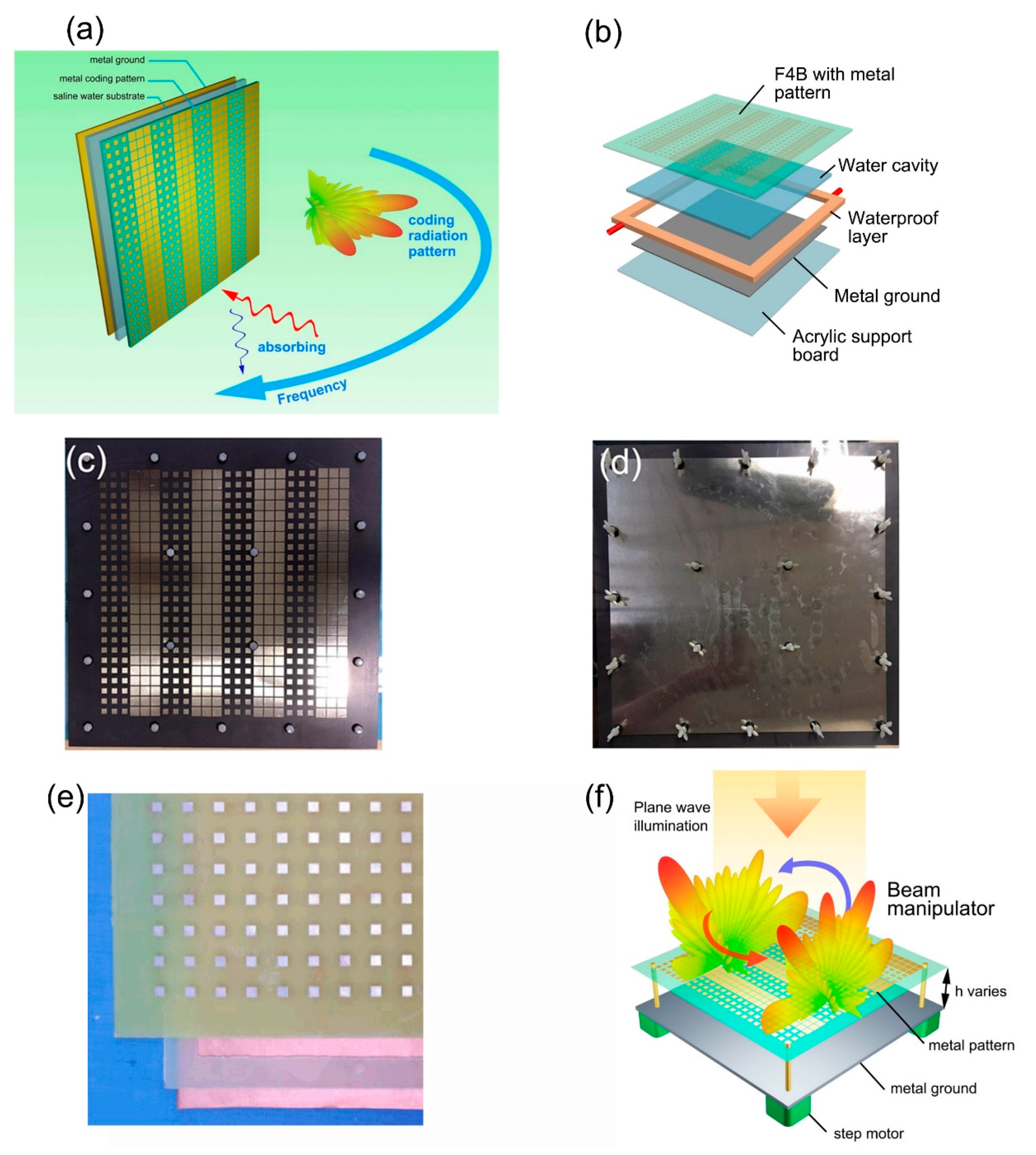

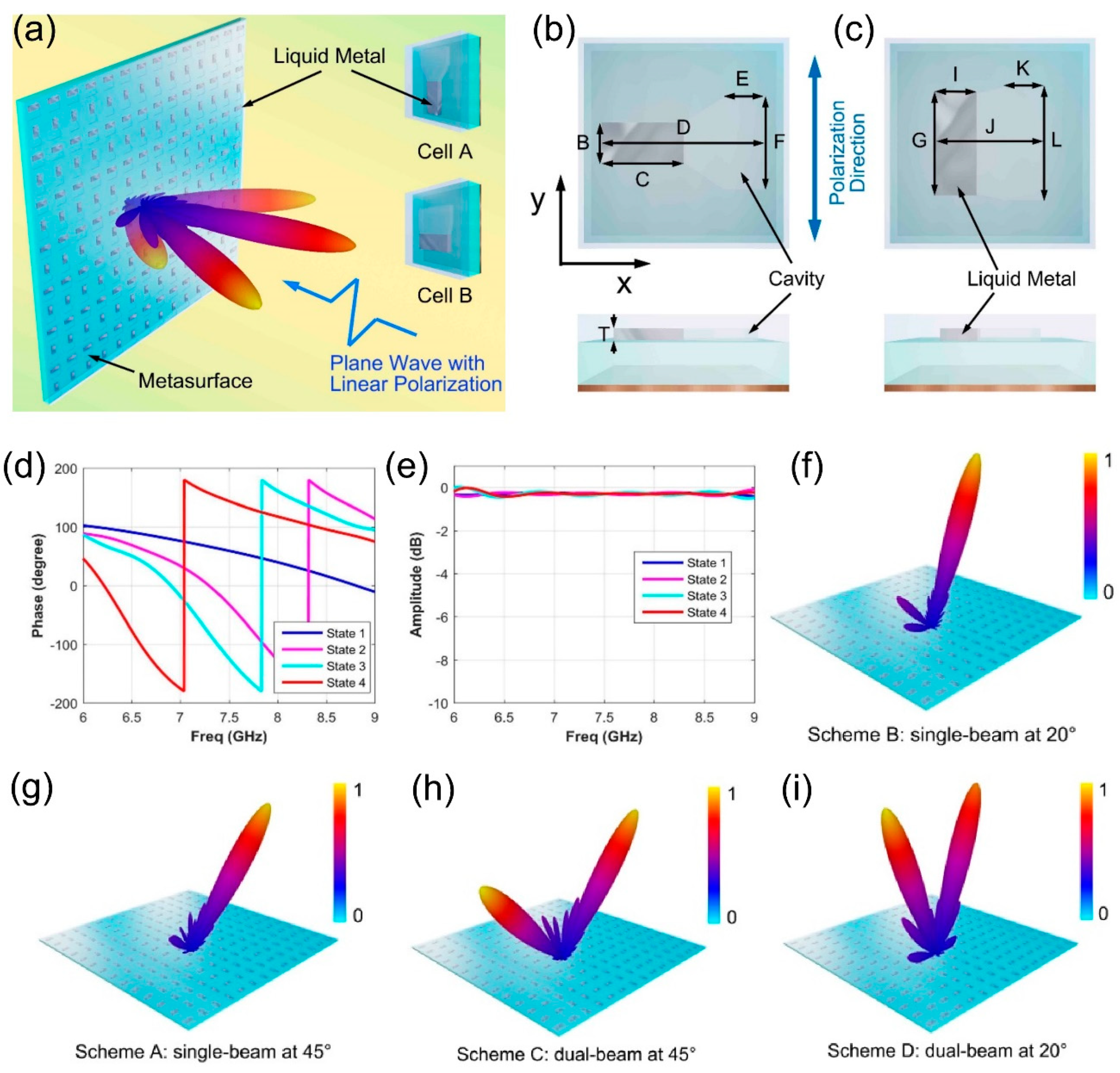
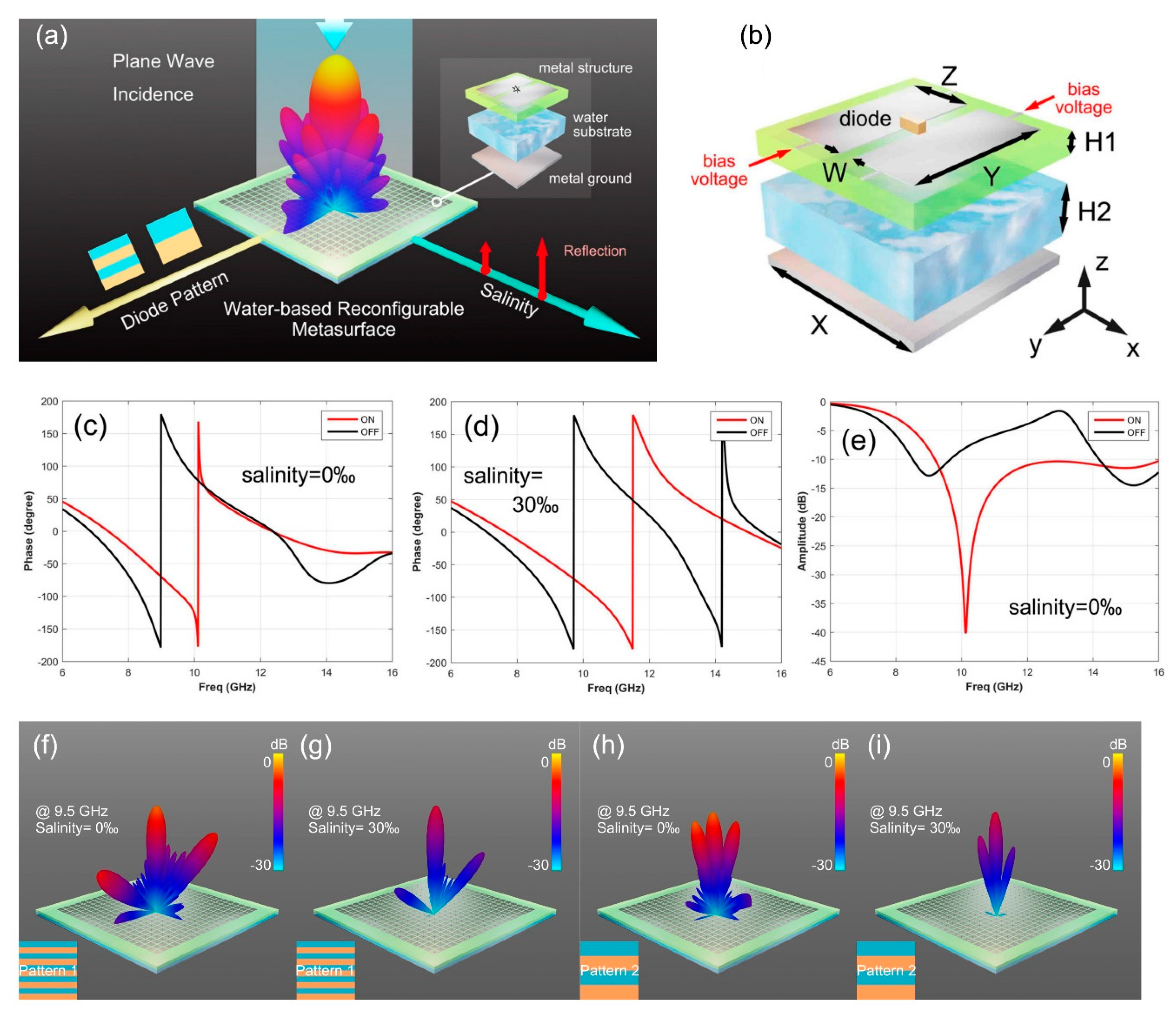


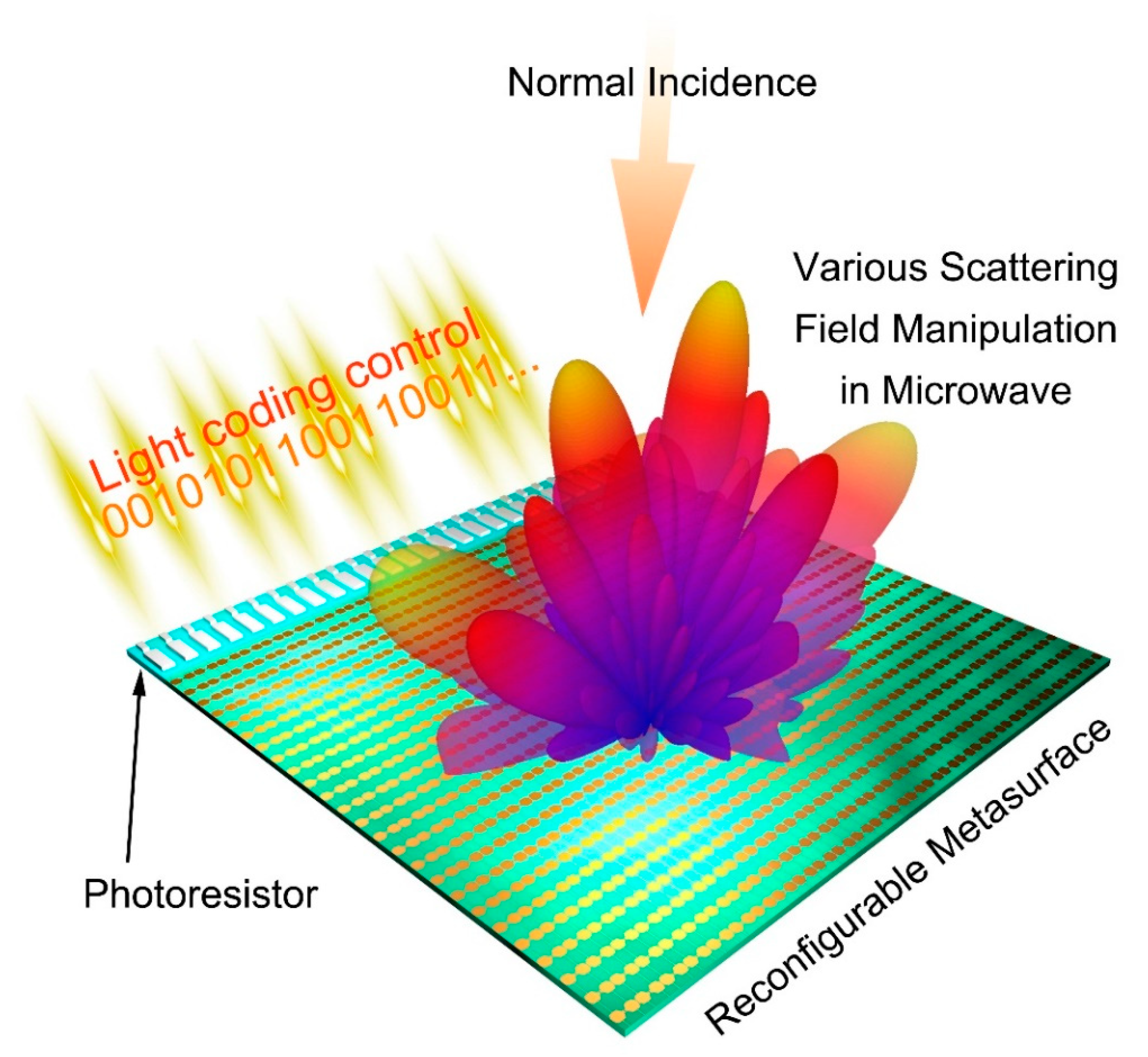

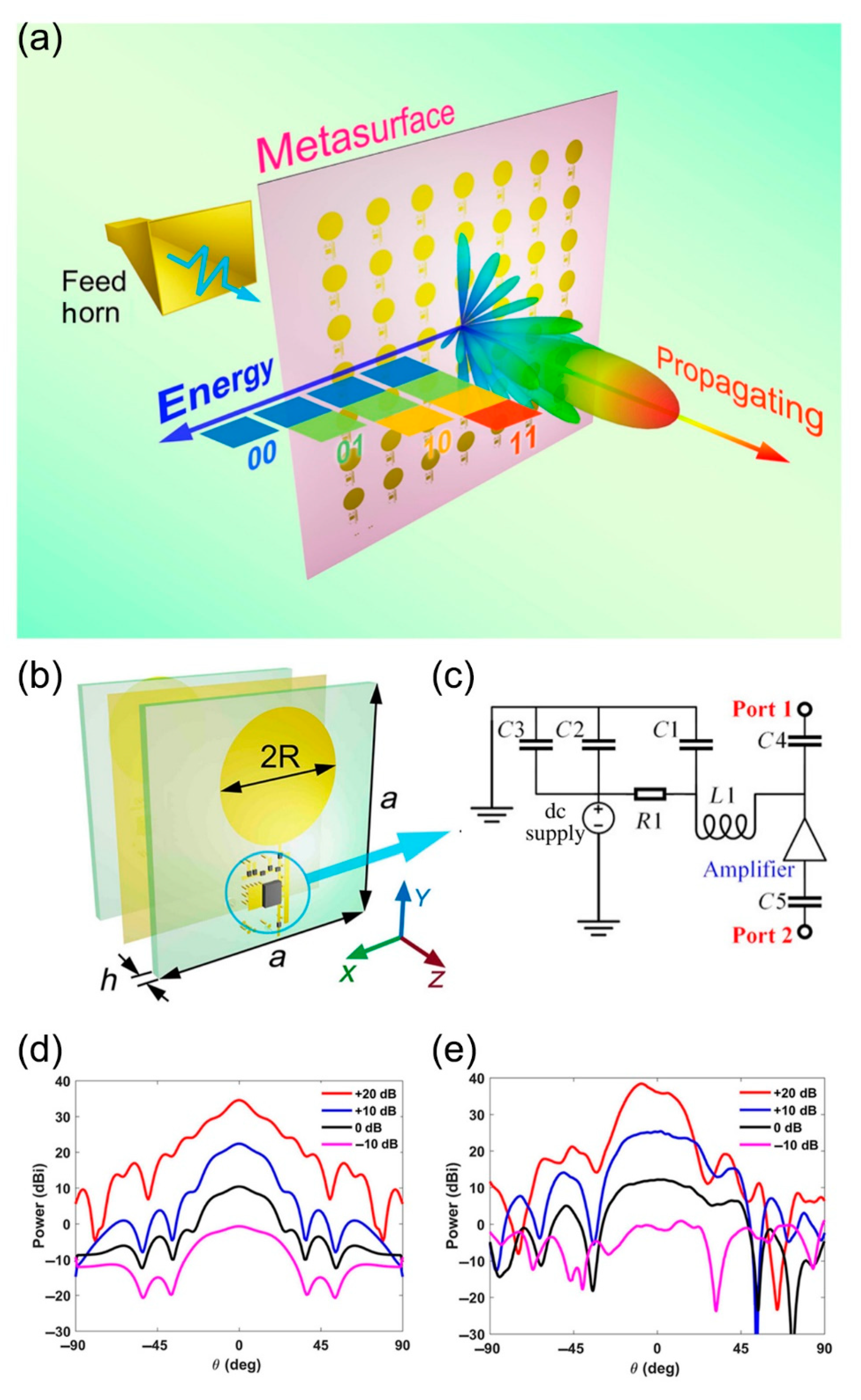
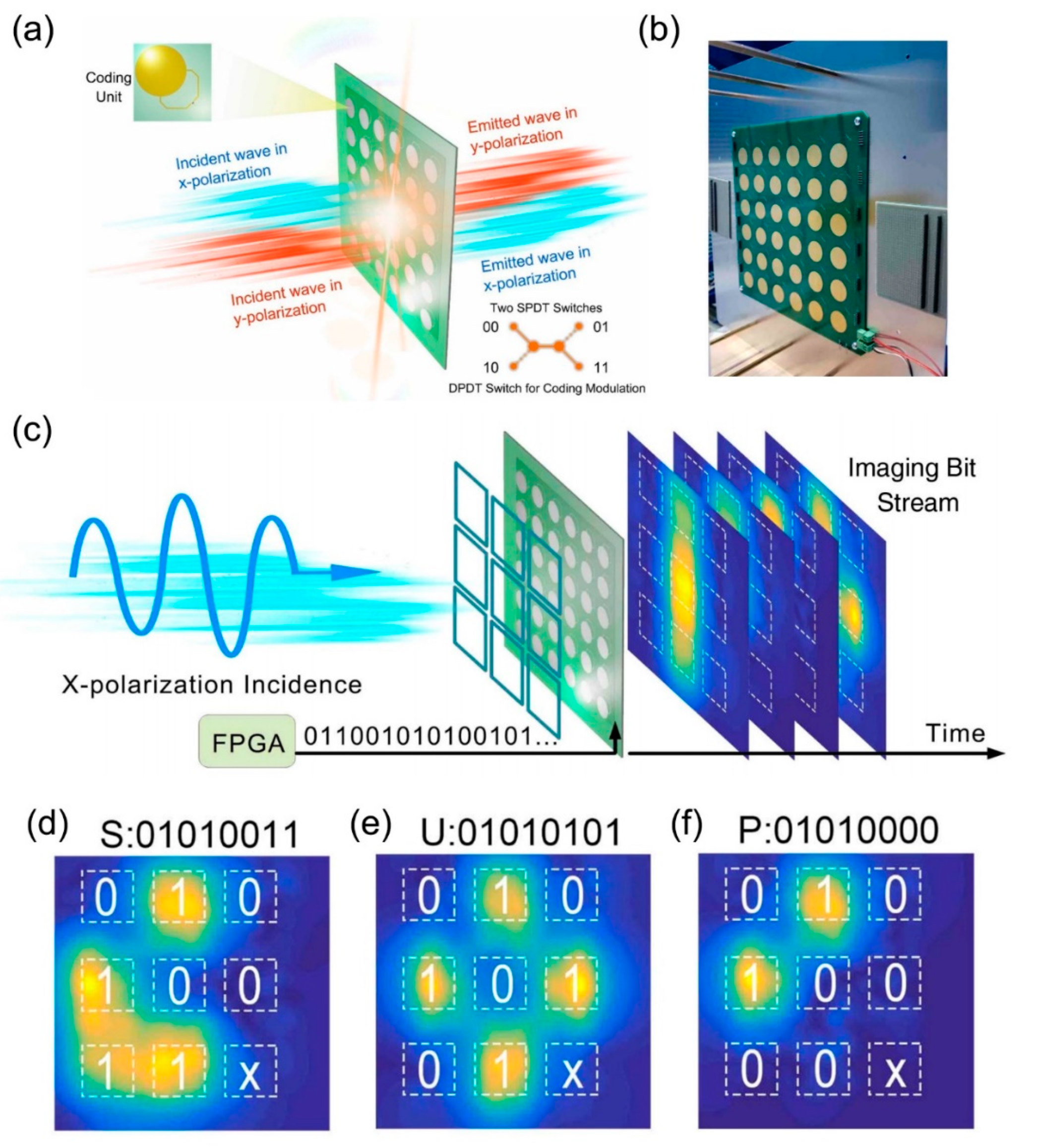
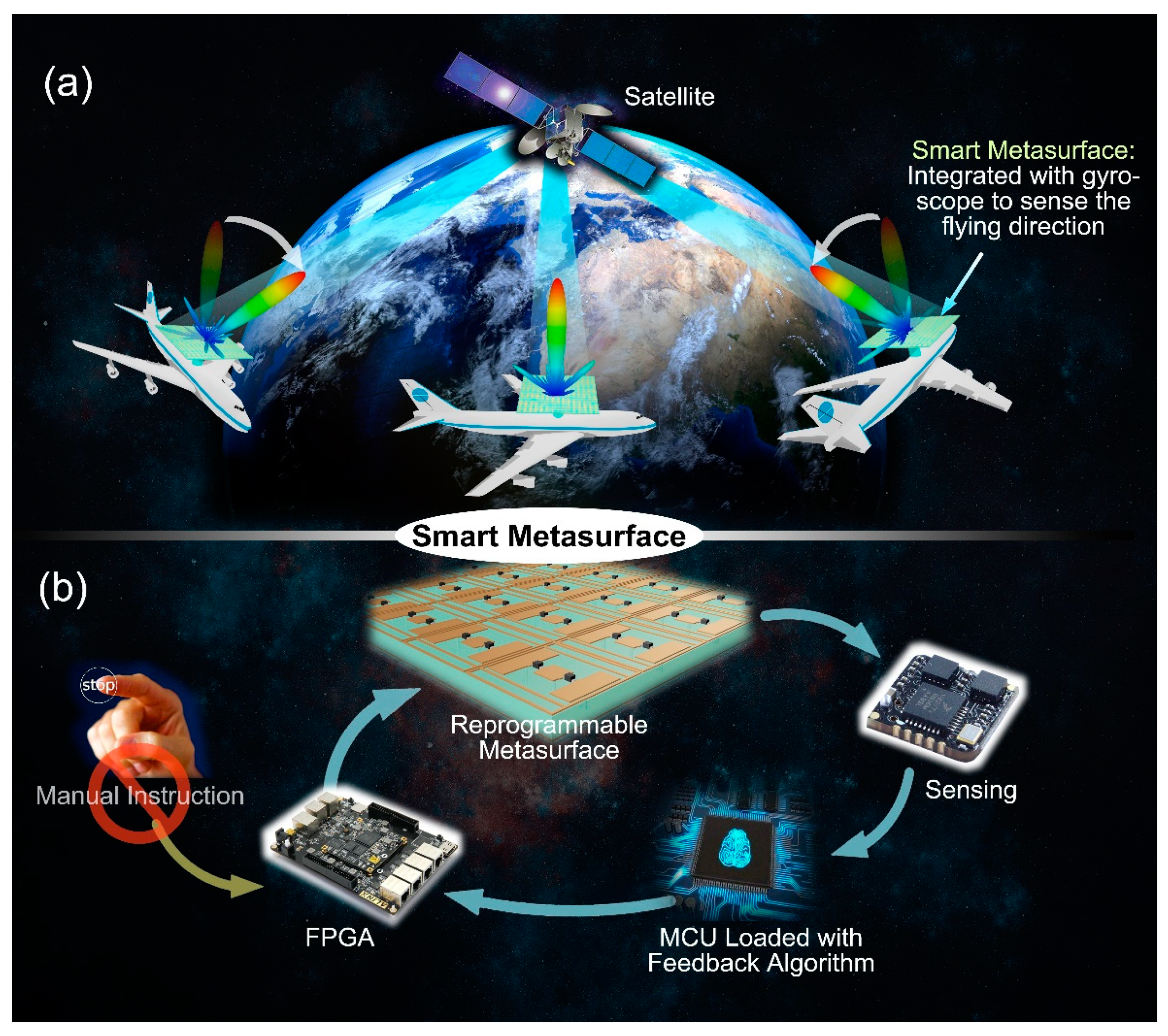
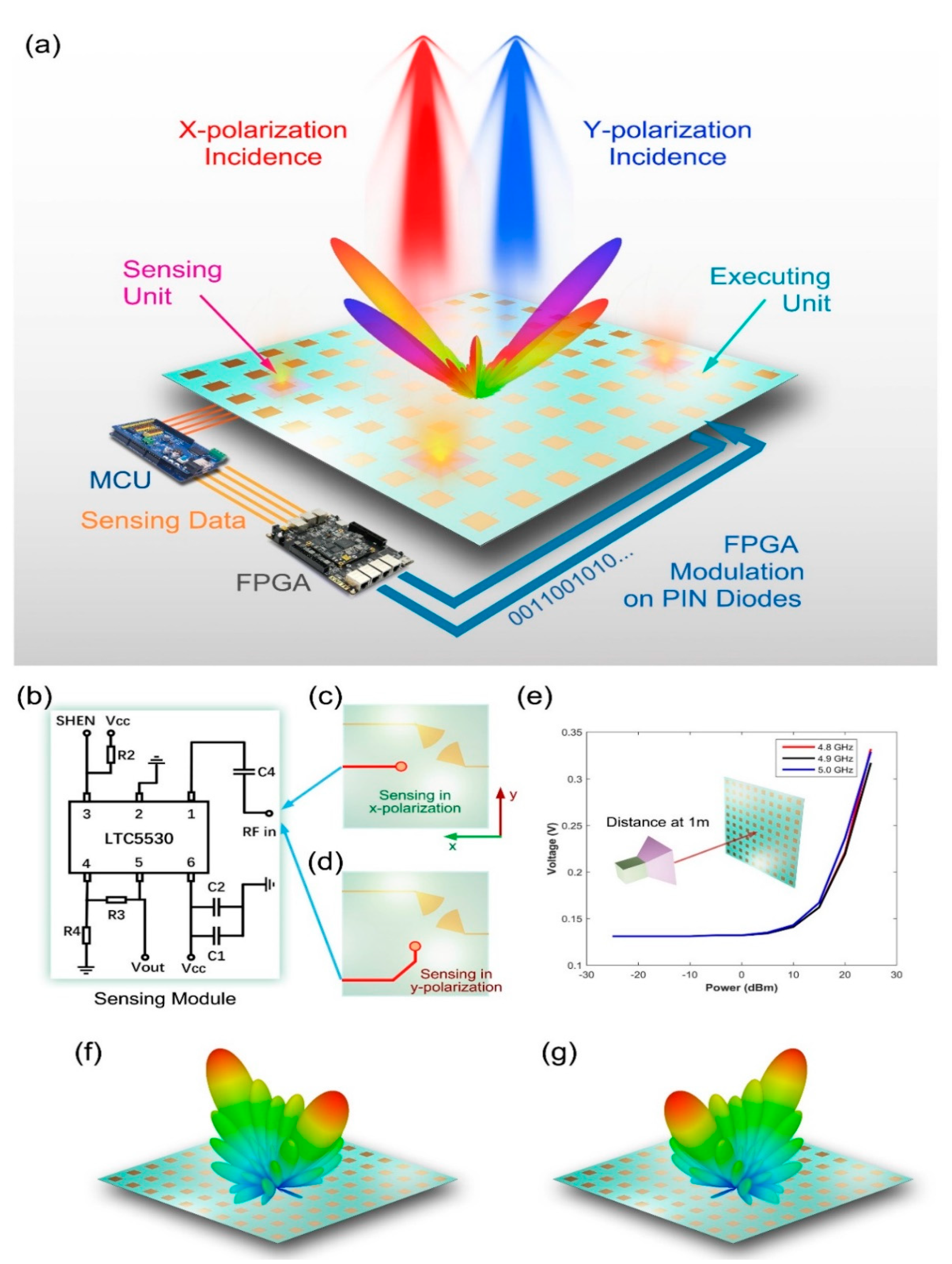
Publisher’s Note: MDPI stays neutral with regard to jurisdictional claims in published maps and institutional affiliations. |
© 2021 by the authors. Licensee MDPI, Basel, Switzerland. This article is an open access article distributed under the terms and conditions of the Creative Commons Attribution (CC BY) license (https://creativecommons.org/licenses/by/4.0/).
Share and Cite
Luo, S.; Hao, J.; Ye, F.; Li, J.; Ruan, Y.; Cui, H.; Liu, W.; Chen, L. Evolution of the Electromagnetic Manipulation: From Tunable to Programmable and Intelligent Metasurfaces. Micromachines 2021, 12, 988. https://doi.org/10.3390/mi12080988
Luo S, Hao J, Ye F, Li J, Ruan Y, Cui H, Liu W, Chen L. Evolution of the Electromagnetic Manipulation: From Tunable to Programmable and Intelligent Metasurfaces. Micromachines. 2021; 12(8):988. https://doi.org/10.3390/mi12080988
Chicago/Turabian StyleLuo, Sisi, Jianjiao Hao, Fuju Ye, Jiaxin Li, Ying Ruan, Haoyang Cui, Wenjun Liu, and Lei Chen. 2021. "Evolution of the Electromagnetic Manipulation: From Tunable to Programmable and Intelligent Metasurfaces" Micromachines 12, no. 8: 988. https://doi.org/10.3390/mi12080988
APA StyleLuo, S., Hao, J., Ye, F., Li, J., Ruan, Y., Cui, H., Liu, W., & Chen, L. (2021). Evolution of the Electromagnetic Manipulation: From Tunable to Programmable and Intelligent Metasurfaces. Micromachines, 12(8), 988. https://doi.org/10.3390/mi12080988





